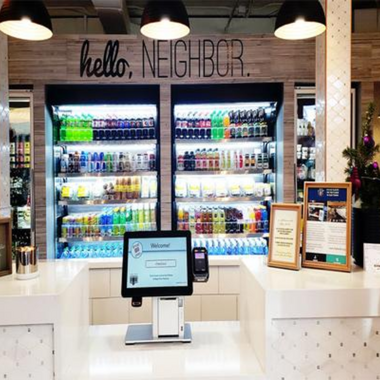
- Five minutes read
Wallet-as-a-service: the next big thing in embedded finance
Today, embedding payments and other financial products into non-financial apps — embedded finance — is the most exciting trend in fintech, and with good reason.
When Travis Kalanick and Garrett Camp came up with the idea for Uber in 2008, they had a simple goal in mind: to make getting a taxi as quick and painless as possible.
The pair had just spent a cold Parisian night unsuccessfully trying to hail a ride to their hotels. The ordeal led to an epiphany. What if you could get a ride whenever you needed one, simply by requesting it through an app on your phone?
Today, Uber has 3.9 million drivers in more than 10,000 cities across the globe.
But while the company will always be best-known for reinventing urban transportation, it also popularised another revolutionary innovation: it made payments part and parcel of its user journey.
With Uber's technology, riders no longer had to fumble for their card or hunt around for cash to pay their fare. The process was seamless and effortless: you hailed a ride, and, once you reached your destination, you got out of the car. The rest, as they say, took care of itself.
Unsurprisingly others took notice and tried to implement a similar version of the technology into their own user journeys.
The hottest trend in fintech
Today, embedding payments and other financial products into non-financial apps — embedded finance — is the most exciting trend in fintech, and with good reason.
Because payments and other financial services products are baked into the user journey, the customer gets the financial product they need, at the right time, without having to leave the app they're using. It's simpler, more convenient, and, most importantly, a frictionless and effortless experience.
But embedded finance is a win for merchants too. Removing friction points at the checkout makes customers more likely to complete their purchases.
Embedded finance has an infinite number of applications and use cases.
But, in our view, one of the most promising and least talked about use cases is wallet-as-a-service — which allows merchants to embed a full-blown digital wallet into their user journeys.
The wallet-as-a-service opportunity
According to our latest Lost in Transaction data, digital wallets are now the most popular consumer payment method after debit and credit cards. This is not surprising. Digital wallets are simple and convenient to use, particularly on mobile, where entering your payment details can be a frustrating experience.
Better still, because you don't have to share your card details for the payment to go through, digital wallets can often be more secure than cards. Plus you can hold multiple currencies, which means you can save money on currency conversion fees when you transact internationally.
With wallet-as-a-service, merchants can start offering their own branded wallets at the checkout, instead of having to rely on third party providers. This means they can control the user experience at every touchpoint — from the moment the customer logs on to the website or app up to the point when payment is approved.
But wallet-as-a-service also has two other compelling benefits for merchants.
Firstly, having access to payment data at a granular level means they can gain a much deeper understanding of their customers' preferences and behaviours: likes and dislikes, when they tend to spend most, and so forth. Data they can use to upsell, cross-sell, and create more personalised and relevant offers.
Secondly, and more significantly, it's a valuable tool that customers will use time and time again in their everyday lives. Which means greater brand awareness, loyalty, and lifetime customer value.
Case in point, in scenarios where transactions are two-way — gaming accounts, trading accounts, and marketplaces, for instance — an embedded wallet allows customers to create their own virtual cards and make faster, smoother deposits and withdrawals.
Getting started with wallet-as-a-service
Embedding a wallet into a product or service open up all sorts of exciting new opportunities. But the reality is that building one from the ground up is unlikely to be feasible for most merchants.
Leaving aside the exorbitant cost of putting together the right tech stack, development, and deployment, creating an embedded wallet in-house would require merchants to reinvent themselves as financial services firms, obtain the right regulatory approvals, and ensure ongoing compliance. And even tech giants like Amazon and Google don't have the appetite for this.
But there's also another way. There are payment services providers who offer a comprehensive, ready-made wallet-as-a-service merchants can white-label and make their own without having to go through the time and expense of building it out or getting their own financial services license.
So how do you pick the right payment services provider to partner with?
There are three key questions to consider:
- How easy is it to integrate the technology into your current systems?
Most reputable payment services providers have comprehensive APIs that work with a wide range of software. But the quality of the support is just as critical to ensuring you roll out your embedded wallet quickly, without a hitch.
Our digital wallets Skrill and Neteller, for instance, have detailed integration guides, brand collateral, and extensive technical documentation to help you get started. And our highly experienced team is always on hand to help out.
- What licenses do they have?
It goes without saying, but a good payments services provider should have the right licences to allow merchants to offer their embedded wallets in every country where they operate.
We not only have strong relationships with regulators across the globe, but can also provide regulatory guidance when rolling out to new markets.
- What's their risk and compliance function like?
While digital wallets can be safer than cards, fraudsters always find a way. And losing customers' sensitive financial data can be the death knell for brands' reputations.
The best payment services providers will have systems in place to ensure merchants stay compliant with regulatory rules and security standards, and robust tools and expertise to help them identify suspicious activity and stop it in its tracks.
Wallet-as-a-service is an unmissable opportunity for merchants
Embedding a digital wallet into your offering enables you to offer your customers greater value and convenience, a more personalised service, and to integrate yourself more deeply into their lives.
But only if you choose your partner wisely.
With Paysafe, you can roll out your embedded wallet across markets quickly and cost-effectively, safe in the knowledge that you're compliant and your customers' data is secure.
Want to learn more about our wallet-as-a-service product? Let's talk about how we can help you.




